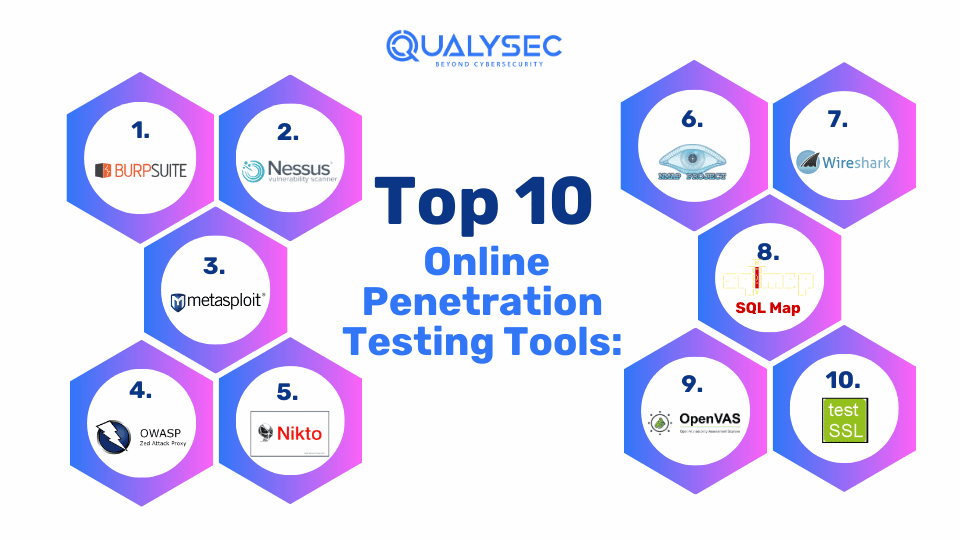In the current digital world driven by technology and specifically the internet, a company’s security is an important aspect for any company regardless of its size. As hackers can seek innovative means to invade system weaknesses, organizations must stay one step ahead and assume an equally proactive approach to the safety of their information. This is where the online penetration testing tools come into play.
Penetration testing or pen testing involves exposure of a system’s security to potential threats to determine any existing flaws in the system. Making use of these online tools enables business organizations to conduct experiments thereby strengthening their protection in advance before the hackers get to discover the weaknesses. In this blog, we will explore the top 10 online penetration testing tools, detailing their key features and how they work to keep your systems secure.
What is Penetration Testing?
Penetration testing is a way of determining the system’s efficiency by making it undergo a simulated attack by outsiders and insiders. Penetration testers, or Ethical hackers try to break through an organization’s security measures to identify flaws so that they may be rectified.
Pen testing tools help to execute some parts of the testing where potential risks, weaknesses, and issues such as open ports, misconfiguration, weak or default passwords, uninstalled updates on the systems, etc., can be discovered. These tools are very important in ensuring that the security of an organization ranging from a large company to a small business is well-checked.
Talk to our Cybersecurity Expert to discuss your specific needs and how we can help your business.
Top 10 Online Penetration Testing Tools

1. Burp Suite
Key Features:
Burp Suite is a comprehensive web vulnerability scanner that supports manual and automated testing. It offers tools for mapping, analyzing, and attacking web applications. Its software was initially created in 2003-2006 by Dafydd Stuttard, who found that the range of automatable tools in security testing of web applications such as Selenium, was rather limited.
Stuttard formed an organization referred to as PortSwigger for the purpose of leading the way for the advancement of Burp Suite. There are both the community, professional, and the enterprise versions of this product.
How it works:
Burp Suite begins with the identification of the application architecture. It then searches for weaknesses in the system like SQL injection, cross-site scripting (XSS), and other web-based vulnerabilities. Another core component of Burp Suite is the repeater that enables manual adjustments to the request and review of the application’s response to the changes made.
Among the many features of Burp Suite, the most fundamental and widely used component is the Proxy. The Proxy makes Burp function as a middleman between the client, which is the web browser, and the server hosting the web application.
2. Nessus
Key Features:
The Nessus project was formed by Renaud Deraison in 1998, as a free remote security scanner project. It is very famous for supporting a wide range of vulnerability scans. It provides insight into the vulnerabilities it detects in operating systems, network devices, and applications and their remedies.
Nessus is a proprietary vulnerability scanner that belongs to Tenable, Inc. Tenable also has what was once called Nessus Cloud, which was Tenable’s Software as a Service offering. The Nessus server is presently available for:
-
- Unix
- Linux
- FreeBSD
How it works:
Nessus can scan these vulnerabilities and exposures:
-
- Products, which may have risks that would permit control or access to a system’s data to unauthorized persons
-
- Misconfiguration, which can lead to a hostile server (for example open mail relay).
-
- Denials of service vulnerabilities (Dos)
-
- Default passwords, few elaborate passwords, and blank/absent passwords on some system account
-
- All the shortcomings in software, absent patches, malware, and misconfiguration errors on various operating systems, hardware devices, and applications are solved by Nessus.
Nessus scans your networks for open ports and weak passwords as well as checks to see if all the applications are up to date. It performs a set of tests for your system’s security and generates a report that grades potential risks depending on the level of risk.
3. Metasploit
Key Features:
Metasploitable is a Linux distribution-focused virtual machine that is specifically designed for penetration testing, training on network security, and practicing on Metasploit Framework. Metasploitable is owned by Rapid7 company which developed the security project known as Metasploit.
Metasploit is one of the most utilized penetration testing platforms which allows users to plan, exploit, and confirm weaknesses in systems. It has a large list of exploits and payloads that come with it.
How it works:
Metasploit works by launching specific exploits against vulnerable systems, allowing testers to mimic real-world attack scenarios It helps to reveal the system’s vulnerability and allows organizations to correct such flaws with time before they are abused.
Unlike other penetration test tools, Metasploit starts with Information gathering where Metasploit works hand in hand with reconnaissance tools such as Nmap, SNMP scanning, or Windows patch enumeration and through Nessus to identify the chink in the armor of your system.
4. OWASP ZAP (Zed Attack Proxy)
Key Features:
OWASP ZAP is an open-source web application security scanner. It is easy to use for beginners and provides a powerful toolset for web application testing. OWASP Zed Attack Proxy (ZAP) is a free software tool for web application security testing.
It features passive scan, automated scanning, scripting, alerts, forced browsing, manual testing, and dictionary lists. It monitors HTTP request and response flow, detects security flaws like SQL injection, XSS, and broken authentication, and allows users to perform simple tasks. ZAP also provides manual testing for developers and users and helps find files and folders in web servers.
How it works:
ZAP is an interface that works like ‘man-in-the-middle’ between the browser and a web application, which observes the actions, builds the preliminary map of the web application resources, records the requests and responses in the application, generates the alert in the case of failure in the request or response or if there is an error with a request-response, and conducts active and passive scan to find the vulnerability as quickly as possible.
5. Nikto
Key Features:
Nikto web server scanner is a vulnerability scanning tool that is also available for free and is an open-source tool that scans the target system against a large number of security checks and vulnerabilities. The tool is compatible with various operating systems such as Linux, Windows, and macOS, and is regularly updated. Nikto has many types of scans, such as dangerous files, outdated servers, and server configuration mistakes.
It also avails several scan modes, does not support particular forms of scans, and comes with the option of having its scan items and plugins updated without requiring further manual input.
How it works:
Nikto is a tool for Linux that operates on a command-line interface. If you are in a Windows environment or prefer a command line with a graphical front end, SensePost has created a Windows version of Nikto known as Wikto.
Wikto is somewhat similar to Nikto and is the one that offers the possibility to work with a GUI. Nikto scans through Web servers by sending multiple requests to determine susceptibility such as the insecure directories, CGI scripts, and default files. It offers an initial evaluation that gives an overall picture of the state of security in a given server.
6. Nmap
Key Features:
Nmap is one of the most popular network scanning tools which has a broad array of users. It assists in the discovery of networks, the listing of hosts, and the determination of which ports and services are open. Gordon Lyon is the founder and CTO of Nmap Software LLC the mother company of Nmap.
Nmap is a network exploration and security auditing tool used in network discovery, security testing, vulnerability detection, and port identification. It can, therefore, identify the host, the services, the operating system, open ports, and even identify vulnerabilities in security. Nmap also helps to show more information about the network’s vulnerabilities and ports.
How it works:
Nmap is a powerful software that can find the hosts and services in a given network, and send information to them, and based on the information received from the network, it will map out the network in detail. It employs several scripts in recognizing threats such as idle scanning, enumeration, spoofing, back orifice, redirection, ports, subnet mask, trailers, stomp, remote commands, Void, imp, and Mène.
Nmap also has no strings attached to its NG and it can be obtained for free thus most internet security companies use the tool in scanning systems for common hacker weaknesses.
7. Wireshark
Key Features:
Wireshark is a network protocol analyzer, Some of Wireshark’s capabilities include packet sniffing and capture, real-time and offline analysis, filtering of packets based on display filters, easy-to-use graphical user interface, packet capture filter, display filter, generation of firewall rules, addition of columns, analysis of ICMP traffic and security based analysis.
Users can filter kinds of network traffic, create firewall rules, append columns, and analyze the ICMP traffic for error alerting and monitoring. It is highly useful for diagnosing network issues and spotting potential security breaches.
How it works:
Wireshark is a tool used to analyze traffic on networks with the use of a protocol analyzer to capture data. It does so by choosing a network interface and employing a packet capture library to monitor all packets that traverse it. After capturing them, Wireshark dissects these packets by examining the packets’ headers, as well as the information contained within the packets, based on such network protocols as the TCP, UDP, and HTTP protocols.
The tool presents data through several panes: Here packet list, detailed protocol analysis, and raw data view are included. There are tools for filtering with the possibility to consider only certain traffic types and using some integrated tools for statistics and report making.
Wireshark is crucial to diagnosing a network problem, studying the security threat, and creating or testing a new protocol. It assists the network administrator and security personnel to have all the important information concerning the network’s behavior and performance.
8. SQLmap
Key Features:
SQLmap is a well-known tool for both detecting and implementing SQL injection attacks. It helps in automating the task of detecting SQL injection vulnerabilities in Web applications.
SQLMap is an automatic identification tool for vulnerabilities and supports the identification of SQL injection and blind SQL injection methods, and can also extract information from databases. It also supports functions like enumeration, fingerprinting databases, and evading methods such as second-order injections.
How it works:
SQLMap is available for Linux, Apple Mac OS X, and Microsoft Windows. SQLmap uses injected SQL statements to interactively access a database in a vulnerable server and extract data. It can work with an extensive list of database management systems and can be utilized to compromise databases.
9. OpenVAS
Key Features:
OpenVAS is an open-source vulnerability scanner that provides a comprehensive suite for detecting security issues in networks and applications. OpenVAS offers comprehensive vulnerability scanning, regular updates, customizable scan configurations, detailed reporting, false positive management, credentialed and uncredentialed scanning, and compliance auditing.
How it works:
OpenVAS is a vulnerability scanning tool that works by scanning a system for vulnerabilities, including misconfigurations, open ports, and outdated software using a given hostname, IP address, or a given range of IP addresses. It then launches a scan, probes the system, and lists the severity, specific software, and issues with a description.
The system associates a severity to each of them generally derived out of the Common Vulnerability Scoring System (CVSS). The OpenVAS generates reports in order with detailed information that may include the vulnerability assessment of the target systems and preventive measures that can be taken amongst other information.
10. Test SSL
Key Features:
TestSSL is a utility package used to check for SSL/TLS security on the client end as well as the server end. It provides full information on the reliability of the applied cryptography methods.
SSL is a standard used for securing internet connection (or between a site or between two servers) since it encrypts the data that is passed between a website and a browser. It prevents hackers from viewing or getting any sent information such as financial or personal details.
How it works:
TestSSL is designed to look for weaknesses in the SSL/TLS settings and can scan for weak ciphers, outdated protocols, and invalid certificates. It helps in protecting data during their transfer across the web network. If you want to verify an SSL certificate on any website, you only need to do two things.
First, check whether the web link of the site starts with HTTP, where the S shows that the website has an SSL certificate. Second, right-click the mouse pointer on the padlock that appears on the address bar to view other information concerning the certificate.
Importance of Using Online Penetration Testing Tools
The rise of cyberattacks has made penetration testing a vital component of any cybersecurity strategy. By using online penetration testing tools, organizations can:
-
- Proactively identify vulnerabilities: Regular pen testing allows businesses to discover weaknesses before hackers exploit them.
-
- Improve security measures: These tools help organizations understand the gaps in their security and provide actionable insights to enhance defenses.
-
- Comply with regulations: Many industries require regular security testing to comply with standards such as GDPR, HIPAA, or PCI-DSS.
-
- Protect sensitive data: Penetration testing helps prevent data breaches that can lead to significant financial and reputational damage.
-
- Increases customer trust: When businesses prioritize security, it increases customer confidence, which is essential in today’s data-driven world.
Conclusion
Online penetration testing tools are essential for safeguarding your systems and networks against cyber threats. The tools mentioned in this blog offer various features tailored to different security needs, from vulnerability scanning and network monitoring to SQL injection testing and SSL/TLS configuration checks. Whether you are a small business or a large enterprise, integrating these tools into your security strategy will help you stay ahead of potential threats.
Regular penetration testing not only improves your organization’s security posture but also ensures compliance with industry regulations and protects your sensitive data.
By integrating these top online penetration testing tools, businesses can maintain a robust defense system, protect sensitive information, and ensure compliance with security regulations.
Frequently Asked Questions
1. What is online penetration testing?
Online penetration testing involves using cloud-based tools and services to simulate cyberattacks on a network or system, identifying vulnerabilities without the need for on-premise installations.
2. What is the timeline for the pentest?
The timeline for a penetration test depends on the scope and complexity of the project. On average, it can take anywhere from a few days to several weeks to complete.
3. What is the cost of online pentesting?
The cost of online penetration testing varies based on the tool, scope of testing, and the specific needs of your organization. Prices can range from a few hundred to several thousand dollars.




































































































































































































































































































































































































































































































































0 Comments